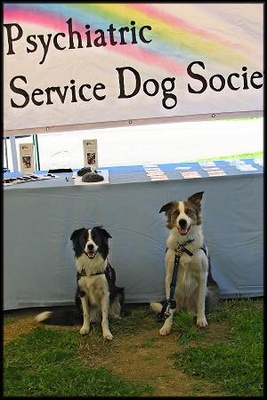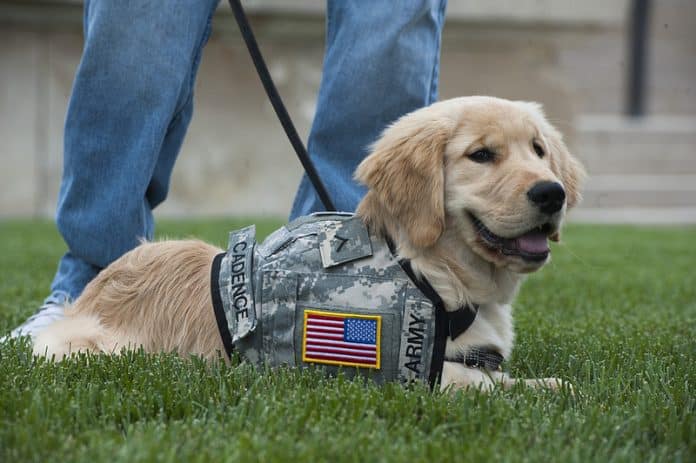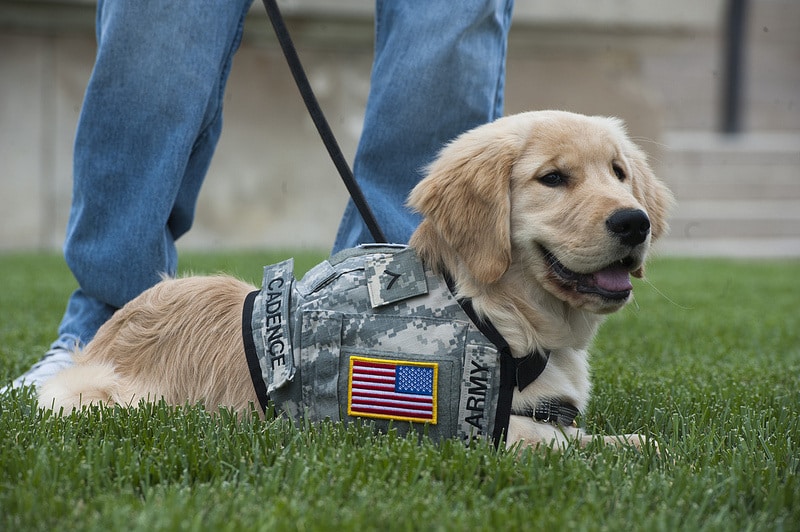The Americans with Disabilities Act (ADA) allows persons living with mental health disabilities to train their own psychiatric service dog.
There are many good reasons for choosing this method as opposed to getting such a dog from a program.
First, owner-trainers get to choose the breed of dog they will partner with. For those of us who are drawn to breeds other than Labradors, Golden Retrievers, and German Shepherds this is an attractive feature.
I am drawn to Rhodesian Ridgebacks. I like the way they look, and I like their hound attitudes. You may want to peruse the many breeds that are available by visiting the website of the American Kennel Club or the Canine Club. It is important that you understand fully the characteristics of the breed that you decide to go with.
 Second, owner-trainers get to raise their own puppy thereby ensuring that developmental stages are transited appropriately, traumas are minimized, and bonding is deep. Owner-trainers get to establish the safety and security that will characterize the rest of their dog’s life. A puppy under your care will never be without its pack leader and will always have a forever home.
Second, owner-trainers get to raise their own puppy thereby ensuring that developmental stages are transited appropriately, traumas are minimized, and bonding is deep. Owner-trainers get to establish the safety and security that will characterize the rest of their dog’s life. A puppy under your care will never be without its pack leader and will always have a forever home.
As such, your puppy will never have the experience of bonding with a human only to have that bond broken repeatedly through changes in handlers and living arrangements. Your puppy will know trust, love, and stability because its heart will be intact. When speaking with your breeder, explain that you want a puppy with a ‘Volhard 3′ temperament.
You can read about the Volhard Puppy Aptitude Test online here.
It is important to properly prepare for your puppy’s arrival. This means reading dog-related books, watching videos, talking to other dog owners, whatever it is that you need to do to become a knowledgeable and responsible puppy parent. There are important decisions that you will need to make, the first of which is, ‘What will I feed my puppy?’
There is a wonderful book titled, “Foods Pets Die For” by Ann N. Martin that I highly recommend. It is an eye opener about the pet food industry. I wish I had known about this book long before I did.
Then there is the issue of puppy vaccinations where more is not necessarily better. Another excellent reading suggestion is “The Nature of Animal Healing” by Martin Goldstein, DVM. Of all the books on dog-related subjects that I have read over the years, Dr. Goldstein’s little paperback had the most profound and lasting impact upon how I choose to raise my dogs today.
 Learning to train your puppy is both challenging and fun. My best recommendation is that you hire a local professional dog trainer with whom you can have weekly one-on-one sessions. The purpose of these sessions is for you to learn how to train your puppy. Importantly, you are not hiring the trainer to train the puppy for you. Basic obedience can be mastered in twelve to sixteen weekly sessions provided that you practice daily. Be aware that every interaction with your dog is a training moment. The rules of the house are always the rules. Consistency is everything in dog training!
Learning to train your puppy is both challenging and fun. My best recommendation is that you hire a local professional dog trainer with whom you can have weekly one-on-one sessions. The purpose of these sessions is for you to learn how to train your puppy. Importantly, you are not hiring the trainer to train the puppy for you. Basic obedience can be mastered in twelve to sixteen weekly sessions provided that you practice daily. Be aware that every interaction with your dog is a training moment. The rules of the house are always the rules. Consistency is everything in dog training!
Strive to become predictable to your dog. When something is promised you should always follow through whether it is a promise to go to the dog park, an opportunity to earn a coveted treat, or simply following through on a command that your adolescent dog is choosing to ignore in the moment. Dogs need structure and daily routines that you both reliably stick to. Even if you don’t feel like walking your dog on a given day, you will do so, because your dog needs it. Exercise directly impacts your dog’s mental health, and you need your dog to be stable, especially when you aren’t.
All service dogs are trained in three areas: basic obedience, public access skills, and disability-related assistance. After mastering basic obedience commands both on and off leash put your puppy through the canine good citizen test and earn the well-regarded credential.
Once passed, it is time to put a vest on your dog. Vests may be obtained online. My favorite supplier is www.raspberryfield.com . They offer lots of colors and the vests are well made.
Importantly, you should never allow your dog to play while wearing its vest. You want the puppy to associate the vest with working. So, take it off if you want your dog to play.
Public access skills take longer to train than the basic obedience behaviors they are predicated on.
Canines for Hope: PTSD Dogs for Service
You should do a minimum of 6 months of public access training.
During this time, your dog will be known as a ‘Service-Dog-In-Training’. It is important that you look up your state’s Service Animal access laws in order to determine if you have public access rights while your dog is in training. Go to the PSDS website and click on ‘PSD Lifestyle’ then, click on ‘State Laws for PSD’.
Be sure to use the suggested key words to the right of each state link. Importantly, the ADA does not give you public access rights with a Service-Dog-In-Training, only when your dog is fully trained.
 By the time you complete six months of public access training, you will have been training with your pup for nine or ten months already. During this time, whether you realized it or not, your puppy was studying your every move, learning your baseline behaviors, attitudes, and dispositions.
By the time you complete six months of public access training, you will have been training with your pup for nine or ten months already. During this time, whether you realized it or not, your puppy was studying your every move, learning your baseline behaviors, attitudes, and dispositions.
When these change, as a result of your being ‘triggered’ or because you are going into an episode of mental illness, your puppy will notice the change. Just as your dog has been studying you, so too, must you begin to study your dog.
When your dog notices that your physiology is changing take note of its facial expressions, body language, and behavior. These will reflect your dog’s cognizance of the change you are undergoing, even though you may feel nothing. Track these events.
Do a check-in with yourself. What are you feeling? What is the context? Learn to’ read your dog as your dog is reading you’. Somatic awareness and insight will follow.
Learning to ‘read your dog as your dog is reading you’ will allow you to intervene in the earliest stages of illness by employing cognitive behavioral skills, engaging risk reduction behaviors, taking PRN medication, or calling your doctor. This is what we in the Psychiatric Service Dog community refer to as ‘doing work’. It is trained behavior, because it relies on the dog having learned your baseline. Learning is training.
Importantly, no one else can teach this to your dog. This is one reason why owner-training a Psychiatric Service Dog is a superior method to getting one from a program. Such dogs know basic obedience, public access skills, and how to perform a repertoire of physical tasks that may or may not be relevant to your disability, but these dogs don’t know how to cue to your changing physiology.
For many Psychiatric Service Dog handlers this form of disability-related assistance is the most valuable because it cultivates insight and offers choices for how to manage episodes of mental illness.
Consider joining the Psychiatric Service Dog Society’s free online communities where you can explore the service dog lifestyle without any commitments. Training your own service dog isn’t always easy, but it is extremely fulfilling and will enrich the relationship you cultivate with your dog.
Joan Esnayra, Ph.D.
Founder of the Psychiatric Service Dog Society.
Canines for Hope: PTSD Dogs for Service
ABOUT THE AUTHOR: Joan Esnayra, Ph.D. is President and founder of the Psychiatric Service Dog Society. Dr. Esnayra has spent the past twelve years pioneering the ‘Psychiatric Service Dog’ therapeutic model. Building upon her analytical training as a scientist, and her insights as a mental health consumer, Dr. Esnayra and members of her online community identified over 30 tasks or functions that Psychiatric Service Dogs may be trained to provide to their owners who are disabled by refractory symptoms of severe mental illness.
Dr. Esnayra and colleagues published the first clinical case study involving the use of a Psychiatric Service Dog in the Journal of Psychiatric Services. Additional publications based upon this growing body of work are in progress. The Psychiatric Service Dog model is a genuine grass-roots empowerment movement that is spreading nationally and internationally. Dr. Esnayra speaks eloquently and with authority on the subject of Psychiatric Service Dogs, by invitation, in venues all over the country.
To date, Dr. Esnayra has spoken at meetings of the President’s New Freedom Mental Health Commission, the National Institutes of Health, the Substance Abuse and Mental Health Services Administration, the Smithsonian Institution, the National Alliance of the Mentally Ill, the Mental Health Association, the American Association of Psychiatric Nurses, the American Association of Medical Colleges, the International Society of Anthrozoology, and the Delta Society.
Most recently her interdisciplinary research group was awarded a clinical research grant from the U.S. Army to test the Psychiatric Service Dog Therapeutic Model in the context of a pilot study at Walter Reed Army Medical Center.
Readers are more than welcome to use the articles I’ve posted on Veterans Today, I’ve had to take a break from VT as Veterans Issues and Peace Activism Editor and staff writer due to personal medical reasons in our military family that take away too much time needed to properly express future stories or respond to readers in a timely manner.
My association with VT since its founding in 2004 has been a very rewarding experience for me.
Retired from both the Air Force and Civil Service. Went in the regular Army at 17 during Vietnam (1968), stayed in the Army Reserve to complete my eight year commitment in 1976. Served in Air Defense Artillery, and a Mechanized Infantry Division (4MID) at Fort Carson, Co. Used the GI Bill to go to college, worked full time at the VA, and non-scholarship Air Force 2-Year ROTC program for prior service military. Commissioned in the Air Force in 1977. Served as a Military Intelligence Officer from 1977 to 1994. Upon retirement I entered retail drugstore management training with Safeway Drugs Stores in California. Retail Sales Management was not my cup of tea, so I applied my former U.S. Civil Service status with the VA to get my foot in the door at the Justice Department, and later Department of the Navy retiring with disability from the Civil Service in 2000.
I’ve been with Veterans Today since the site originated. I’m now on the Editorial Board. I was also on the Editorial Board of Our Troops News Ladder another progressive leaning Veterans and Military Family news clearing house.
I remain married for over 45 years. I am both a Vietnam Era and Gulf War Veteran. I served on Okinawa and Fort Carson, Colorado during Vietnam and in the Office of the Air Force Inspector General at Norton AFB, CA during Desert Storm. I retired from the Air Force in 1994 having worked on the Air Staff and Defense Intelligence Agency at the Pentagon.
ATTENTION READERS
We See The World From All Sides and Want YOU To Be Fully InformedIn fact, intentional disinformation is a disgraceful scourge in media today. So to assuage any possible errant incorrect information posted herein, we strongly encourage you to seek corroboration from other non-VT sources before forming an educated opinion.
About VT - Policies & Disclosures - Comment Policy





